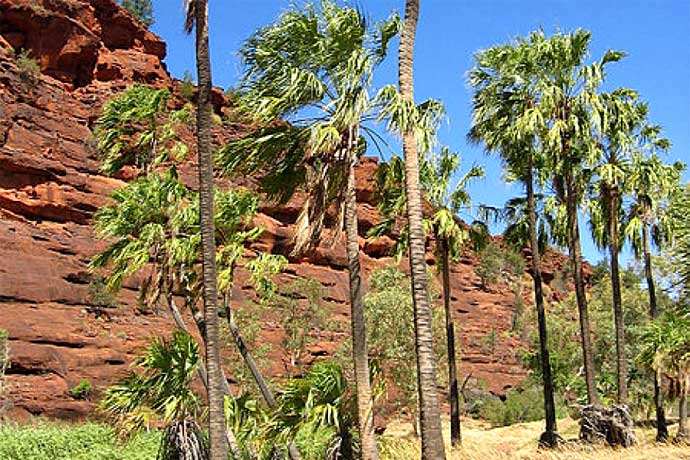Research findings back up Aboriginal legend on origin of Central Australian palm trees

(ABC/Wikipedia)
Alister Doyle 3 April 2015 ABC Science (Reuters)
The scientific world is stunned by research which backs an Aboriginal legend about how palm trees got to Central Australia.
Several years ago Tasmanian ecologist David Bowman did DNA tests on palm seeds from the outback and near Darwin.
The results led him to conclude the seeds were carried to the Central Desert by humans up to 30,000 years ago.
Professor Bowman read an Aboriginal legend recorded in 1894 by pioneering German anthropologist and missionary Carl Strehlow, which was only recently translated, describing the "gods from the north" bringing the seeds to Palm Valley.
Professor Bowman said he was amazed.
Palms once grew in ice-free Arctic
Palms flourished in the Arctic during a brief sweltering period about 50 million years ago, according to a study that hints at gaps in our understanding of modern climate change.
"We're talking about a verbal tradition which had been transmitted through generations possibly for over 7,000, possibly 30,000 years," he said.
"Just an amazing coincidence that we'd independently concluded that the seeds had been transported and then subsequently we discover an Aboriginal legend is exactly what we found scientifically.
"The concordance of the findings of a scientific study and an ancient myth is a striking example of how traditional ecological knowledge can inform and enhance scientific research.
"It suggests that Aboriginal oral traditions may have endured for up to 30,000 years, and lends further weight to the idea that some Aboriginal myths pertaining to gigantic animals may be authentic records of extinct megafauna."
The research has been published in the Nature magazine.
Wednesday, 7 March 2012
Anna Salleh ABC Science

(ABC/Wikimedia)
Australian scientists say an often-told tourist story about how an iconic Central Australia palm came to be is nothing but a lovely myth.
A team of Australian and Japanese researchers report their findings today in the Proceedings of the Royal Society B.
"We've just demolished a textbook story," says team member, Professor David Bowman an environmental change biologist at the University of Tasmania.
The red cabbage palm, Livistona mariae, is a threatened species that is unique to the Finke Gorge near Alice Springs in Central Australia.
Northern Territory government promotion describes the palm as "a survivor from our rainforest past" - a relic, left over from Gondwanan times when Australia was covered in rainforest.
But Bowman and colleagues have found otherwise.
In previous research they found Australian palms came from a Southeast Asian ancestor that was adapted to growing in dry environments, and only adapted to growing in rainforests later on.
Bowman and colleagues used a genetic analysis to conclude that L. mariae is actually the same species as another Livistona palm, L. rigida, which grows in two pockets some 1000 kilometres away in northern Australia.
The findings feed into a long-standing debate over whether the two are actually the same species or not.
In their most recent study Bowman and colleagues examined the genetic relationship between the L. mariae and L. rigida in more detail.
They compared genetic fingerprints called nuclear microsatellite loci in 14 populations of L. mariae and L. rigida.
The researchers looked at L. mariae from the Finke Gorge's Palm Valley oasis, and L. rigida from Mataranka, just south of Katherine, and from Lawn Hill near Mount Isa.
They found L. mariae was most closely related to the L. rigida from Mataranka, but the most surprising discovery was how recently the two diverged.
After checking and double checking for months, the final estimate was that the L. mariae and L. rigida became separated just 15,000 years ago, completely ruling out that the palms in Palm Valley oasis are relics from Gondwana.
"What was shocking for us is that divergence was so recent, within the time period humans have been in Australia. We thought, 'Yikes, that's amazing'," says Bowman.
"The results tell us something transported seeds from Mataranka which is just south of Katherine to Palm Valley 15,000 years ago."
Long-distance dispersal
Bowman says that genetics is repeatedly showing how often outlying populations are not relics, but a product of long-distance dispersal instead. Another dispersed plant which was mistakenly believed to be a Gondwanan relic is the baobab.
But what dispersed L. mariae to Finke Gorge?
Bowman says, while a river could have been responsible for dispersing the seeds of L. rigida from Mataranka to Mt Isa via the Gulf of Carpentaria, there are no rivers to connect Mataranka to Finke Gorge.
A bird could have spread the tree to Central Australia and yet there is no evidence birds spread L. rigida to jungles nearby current established populations.
Another possibility is that it was spread by Aboriginal people who eat parts of the palm and use other parts for weaving, says Bowman.
But why would take them 1000 kilometres and nowhere else?
"It's a beautiful mystery," muses Bowman.

